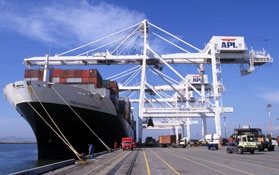Posts Tagged: trade
UC ANR to host exchange in Northern California promoting business partnerships across the Americas
The tenth Americas Competitiveness Exchange on Innovation and Entrepreneurship (ACE) will be held for the first time in Northern California in October. To promote partnerships, the exchange will bring economic and political leaders from across the Americas and beyond to visit Northern California's world-class innovation and entrepreneurship ecosystems, and to experience the best California has to offer in food, wine and local products. The milestone “ACE 10” is sponsored by the University of California Agriculture and Natural Resources, Central Valley AgPlus and other California partners.
From Oct. 21 to 27, approximately 50 high-level economic and political leaders from across the Americas, selected through a competitive application process, will participate in ACE 10, which will highlight innovation and entrepreneurial activity.
ACE 10 program themes include:
o Improving health: Bioscience, food safety, healthy food access and nutrition
o Feeding the world: Sustainable food systems & communities, food security, ag tech
o Maximizing resources: Resource management, water and energy, waste-to-energy uses
o Fostering resiliency: Environmental sciences, mobility, global leadership
o Innovation ecosystems: Innovation communities, supporting entrepreneurs, financing ventures
“The University of California is pleased to host the milestone ACE 10 in Northern California to highlight our world-class innovation and entrepreneurship that drives local and regional economic development,” said Glenda Humiston, UC vice president of agriculture and natural resources. “We look forward to building new and lasting partnerships across the Americas.”
The ACE 10 program will start in San Francisco at UCSF's renowned biotech research center and start-up incubator in Mission Bay, followed by a visit to NASA Ames Research Center. The tour includes stops in Santa Cruz, Monterey, Salinas, Fresno, and Davis, and will conclude in Sacramento. Site visits will focus on food and agriculture, water and energy technologies, life and environmental sciences and advances in manufacturing.
“It's a tremendous honor and important opportunity for Northern California to host the 10th Americas Competiveness Exchange,” said Valley Vision's chief executive Bill Mueller. “Hosting this global delegation gives California not just the chance to showcase our assets, but also provides an unmatched platform to build global economic and research alliances.”
Gabriel Youtsey, UC ANR chief innovation officer agrees. “Innovation and entrepreneurship are California's biggest ‘exports' to the world and we aim to set off the next wave of innovation in our state's distinct areas of strength: food, agriculture and life sciences.”
The agenda is designed to provide the delegates opportunities for interactive learning, sharing of best practices, networking and partnership development as they travel from the coast to the inland areas of the state. “During the tours, our visitors will discover opportunities and create new collaborations that will continue to flourish long after they return to their home countries,” Humiston said.
ACE toured the Arizona-Southern California corridor in 2016. The most recent exchange, ACE 8, was held in Florida in December 2017. ACE 9 will be held in Israel and Germany this June where the baton will be passed to Humiston to take lead on ACE 10.
Valley Vision—a civic leadership organization headquartered in Sacramento that is committed to building a prosperous and sustainable future—is a co-host for ACE 10, along with UC ANR. The Northern California leadership team also includes California State University, Fresno and California State University, Chico; the cities of Davis, Fresno, Sacramento, Salinas, San Francisco and Santa Cruz; Bay Area Metro and Monterey County. The successful bid to host ACE 10 is an outgrowth of the Central Valley AgPlus food and beverage manufacturing consortium.
The principal ACE convening institutions are the U.S. Department of Commerce, through the International Trade Administration (ITA) and the Economic Development Administration (EDA); the U.S. Department of State; the Government of Argentina;and the Organization of American States (OAS) as the Technical Secretariat for the Inter-American Competitiveness Network (RIAC). ACE is a core component of the Work Plan of the Inter-American Competitiveness Network.
Past examples of mutually beneficial partnerships developed by ACE exchanges include:
• Research centers and co-ops such as Organic Valley in Wisconsin and Escuela Superior Integral Lecheria (ESIL) of Villa María in Cordoba, Argentina, working on business and export development in the dairy industry;
• Young entrepreneurs from UNITEC Honduras interacting and collaborating with the entrepreneurship ecosystems led by UC San Diego;
• An industrial internship program between Canada and Mexico through Mitacs, a Canadian not-for-profit research and training organization, and Mexico's National Council of Science and Technology (CONACYT).
UC economists project farm export gains from free trade agreements
Analysis of the recently approved United States free trade agreement with South Korea in the April-June 2011 issue of the California Agriculture journal shows how California farm exports will now have much improved access to the large South Korean market, significantly enhancing competitive prospects for almonds, walnuts, dairy products, beef and oranges, among other important California commodities.
Legislation implementing the Korea free trade agreement, along with smaller agreements with Colombia and Panama, were negotiated several years ago. They finally gained Congressional approval on Oct. 12 and are set to be signed by President Obama on Oct. 21.
By phasing out or eliminating tariffs and other trade barriers, free trade agreements create larger markets for California-produced farm commodities. Since South Korea has no significant prospects to export farm goods to the United States, California agriculture is a clear winner from this agreement.
Hyunok Lee and Daniel Sumner from the Department of Agricultural and Resource Economics at UC Davis and the UC Agricultural Issues Center document the current importance of South Korea to California farm exports, the size of the trade barriers these exports have faced (many facing tariffs of more than 30 percent) and the advantages currently afforded by South Korea’s existing free trade agreements with important competitors, such as Chile and Australia.
“Lower trade barriers will allow California agriculture to better compete in a large, growing and lucrative market,” said Sumner.
“Food product prices are high in South Korea and consumers are willing to pay premiums for the high-quality products produced in California,” added Lee.
South Korea has a strong economy with about 50 million consumers and per-capita income of $30,000, higher than many European countries. In 2010, the value of California farm exports to South Korea was more than $400 million. Given the size of South Korea’s economy and the high trade barriers being erased, Sumner and Lee say the accord will do more for farm exports than agreements negotiated for almost 20 years.
Among other findings, the authors report that:
- The top California ag exports to South Korea are fresh oranges, with tree nuts, rice, and beef and beef products also in the top five.
- Other California crops that hold a double-digit share of the South Korean market are hay, grape juice and kiwifruit.
- With an import tariff of about 45 percent, South Korean imports of California table grapes, fresh strawberries, fresh apples and lettuce and rice are small, but have great potential for growth.
- South Korea is becoming a major export market for California grapefruit and lemons. Lower tariffs will increase demand.
- The United States is South Korea’s only supplier for almonds and the U.S. has more than a 90 percent share of walnuts. The current 8 percent almond tariff will be eliminated and walnut tariffs will be phased out over the next 6 to 15 years.
- Beef products are the top agricultural import (from all sources) into South Korea by value. With the new agreement, the within-quota tariff will fall by 2.7 percent each year, providing a gain for U.S. producers compared to import competitors.
- South Korea has high trade barriers for many dairy products, but with gradual reductions under the new agreement, the market will grow.
MEDIA CONTACTS:
Daniel Sumner is available to comment on the free trade agreements with South Korea, Panama and Columbia. He can be reached at dasumner@ucdavis.edu, (530) 752-1668.
Hyunok Lee can comment about the size and potential growth of the Korean market. She can be reached at (530) 752-3508, hyunok@primal.ucdavis.edu.


